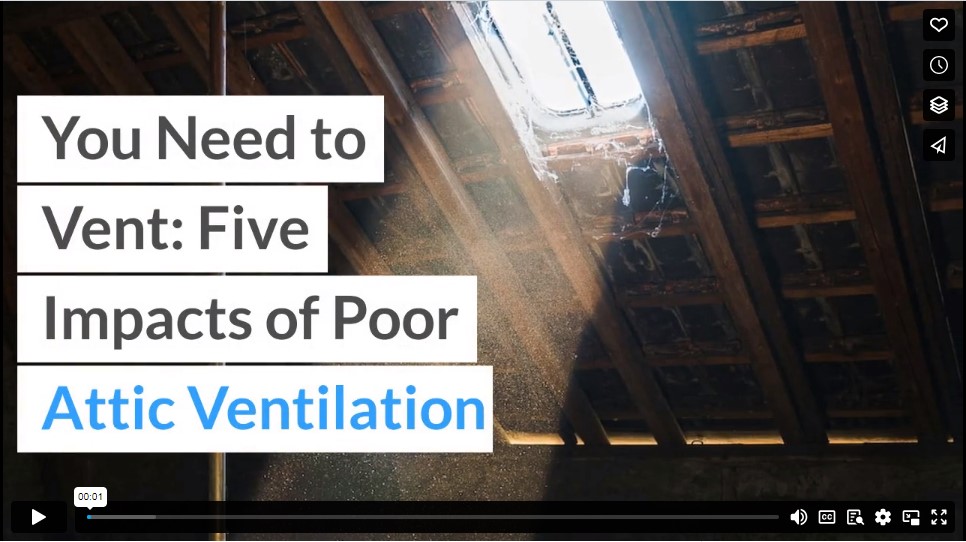We all need to let off some steam occasionally, and your home is no exception. Hot air from throughout your house rises into your attic space. From there, it needs to be able to escape. Otherwise, your home suffers the same fate we all do when we can’t find healthy ways to let off steam: declining health and physical damage. Here are five ways poor ventilation in your attic can cause problems.
1. Increased Energy Costs
Hot air rises. That means the heated air in your home makes its way up to your attic space. Hopefully, it then escapes through vents, allowing your home to breathe and cool off. Not only does the hot air escape, but as it leaves, it pulls in cooler, fresher air that circulates throughout the house.
If the hot air doesn’t escape, you have an accidental sauna sitting on top of your house. That leaves your home full of hot, stale air. That will drive up your energy bills, particularly in summer when you are fighting the heat and relying on the natural cooling effect that comes from your house, breathing out the hot air and breathing in the cooler air. When your attic isn’t well-vented, your home can’t breathe, leading to suffocatingly high energy bills.
2. Decreased Lifespan of Your Roof
Excessively hot temperatures and damp air aren’t healthy for your roof. Sustained exposure to unnaturally high temperatures can degrade your roof more quickly. Since a new roof is a significant investment, you want to do what you can to make sure you are protecting it. That means confirming with your roofing contractor that you have all the necessary vents, which will extend the lifespan of your roof.
3. Invalidated Roof Warranties
Most roofing products come with a warranty. However, manufacturers are only willing to guarantee products that are used correctly. They know the conditions their materials can withstand. You may void your warranty if you ask your roof to do something outside the expected conditions. That includes forcing your roof to operate over an improperly vented attic. This is another reason it is critical to confirm with your roofers that your newly installed roof has the appropriate ventilation.
The price of your new roof materials includes the warranty cost, so ensure you get what you pay for. Protect that warranty, and your roof, by ensuring you aren’t creating conditions unfavorable to your roof and contrary to your warranty.
4. Ice Dams
Ice dams form when the snow on your roof melts and then refreezes into sheets of ice. That ice can be dangerous when it releases and falls from your roof. It is also harmful to your roof material. Ice dams harm shingles and gutters and can even lead to leaks that damage the interior of your home.
One cause of roof dams is attics with insufficient ventilation. If your attic cannot breathe, trapped heat can warm your roof from the underside, causing the snow to melt and refreeze when temperatures drop. This cycle of thawing and freezing leads to ice dams. You can prevent much of that thawing with proper attic ventilation.
5. Moisture Damage
When warm air is trapped in your attic, the moisture held in that damp air can turn to condensation. Think of this like the hot, moist air of a summer day hitting your cooler glass of lemonade. The moisture condenses and turns back into liquid water. When that process happens inside your home, it is problematic. It can cause water damage to your roof’s supporting structure or lead to your shingles buckling. Remember how we said earlier that an improperly vented attic could void your roofing warranties? This is part of the reason why.
Even in our relatively dry summers, roofing contractors in Salt Lake City and across Utah know the ill-effects that come from condensation due to a lack of attic vents.
Additionally, the moisture from all that unvented hot air can cause mold, which loves to grow in hot, damp spaces. Given that some kinds of mold are dangerous and many are difficult and expensive to remediate fully, it is something you want to avoid. The vents in your attic can help you do that.
All of these issues are easily addressed by properly venting your roof. With a new roof installation, confirm with your contractor that their plans include sufficient venting. If you aren’t certain whether your current roof provides proper attic insulation or you see signs of some of the problems we’ve discussed, consider getting a roof inspection.
Roofing companies in Utah should be able to assess whether your home is properly ventilated. A trusted roofer can also offer options for addressing a lack of vents and can handle any damage caused if your attic hasn’t been able to let off any steam.
Infographic
Discover the vital impact of attic ventilation in this infographic, outlining consequences like high energy costs and structural damage. Inadequate venting transforms your home into a sauna. Learn about decreased roof lifespan, invalidated warranties, ice dams, and moisture damage. Understand the importance of proper ventilation for healthier living space and safeguard your investment by confirming with roofing contractors.

Video

